The Biggest Party in Nebraska Is on This River
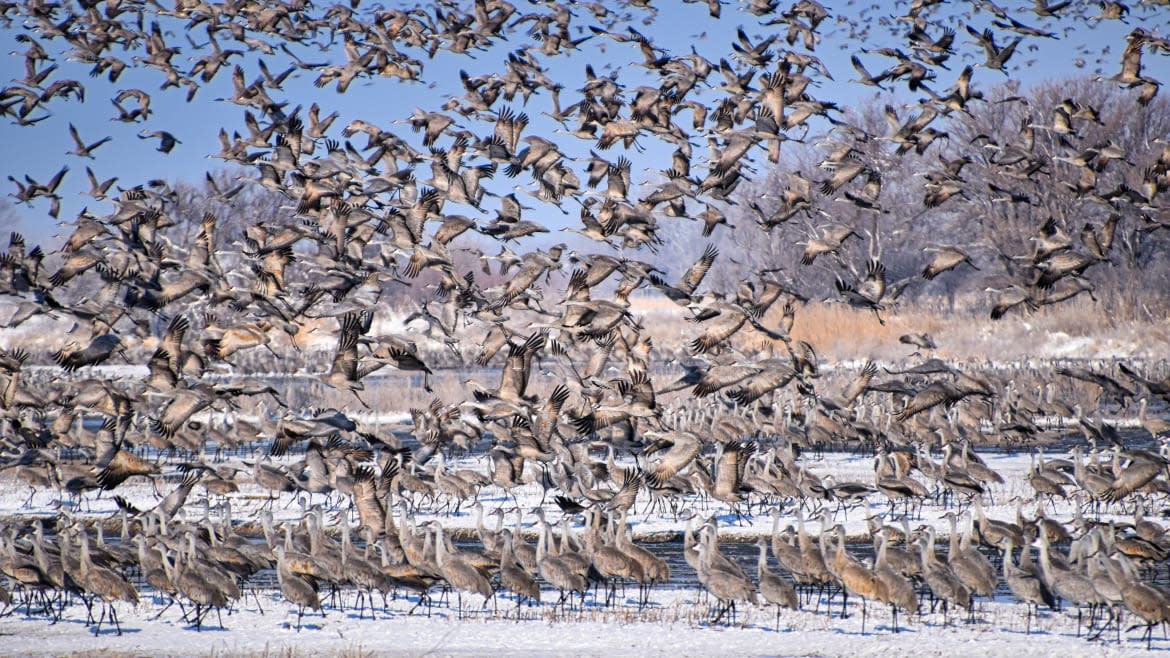
“Going my way?” I asked, hopping into a white school bus stopped along a road just outside of North Platte, Nebraska. The driver, who donned a chocolate brown coat and a chocolate brown cowboy hat, reached out with a firm handshake.
“You must be Brandon. Grab a seat.”
My flight had run late and the tourism office had tracked down the bus owned by Dusty Trails—a tour company owned by Dusty Barner. The buses take guests from field to field, spotting sandhill cranes that are eating waste grain.
Every year in March and April, a million sandhill cranes migrate from the U.S.-Mexico border northward to the Platte River in Nebraska. They’ve been doing it for millions of years and it is the biggest bird migration in North America. Roughly 80 percent of the sandhill cranes use this route. They are a massive tourism draw for the cities of North Platte, Kearney, and Grand Island. (I was there at their invitation.)
It’s been a few years since the last economic impact study of the migration on Central Nebraska, but in 2017, it had a value of $14.3 million, “supporting 182 year-round equivalent jobs.” The pandemic slowed that down, but tourism offices told me visits were back in full-force.
I’ve wanted to see the sandhill crane migration for years. In December, while I was solo-hiking on my birthday in Ohio, 75 of them flew overhead. That felt like a big deal, that is, until I arrived in Nebraska. I’m told Jane Goodall, who comes to Nebraska every year for the cranes, has compared it to the great wildebeest migration through the Masai Mara in Kenya. That feels right.
Sandhill cranes have a presence that is hard to ignore.
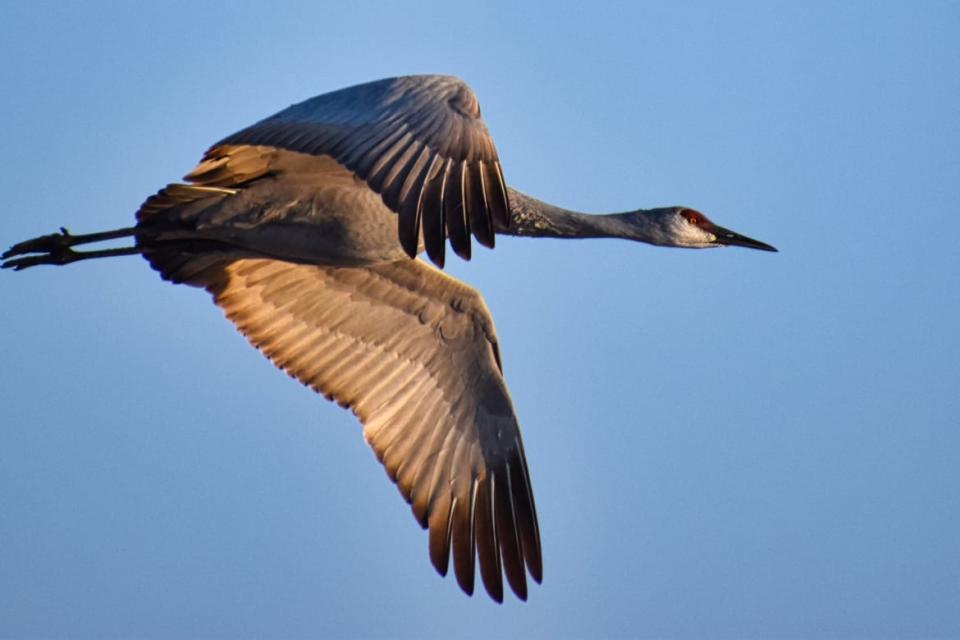
Sandhill crane in flight in Kearney, Grand Island, Nebraska.
They are large birds, standing upwards of four feet, with wingspans of six to seven feet. You don’t just hear those wings flap overhead, you feel it in your chest. They are also among the most ancient birds on the planet, with the oldest crane skeleton found in Nebraska being around 2.5 million years old. And then there is their call: a bugling sound that churns in the throat. It is how you might expect something like a flying dinosaur to sound, which makes sense since birds are the descendents of theropods.
North Platte is a newer player in sandhill crane tourism. During the day, the cranes are out in the fields picking at waste grain to fatten up. They will eventually leave the river and travel further north in the U.S., Canada, Alaska, and Siberia. Dusty Trails’ bus tour gives guests a chance to see them when they aren’t on the river. They use private bird blinds for guests to see them return to the river in the evening and lift off in the morning. (A blind is a structure designed for quietly watching the birds without frightening them off.)
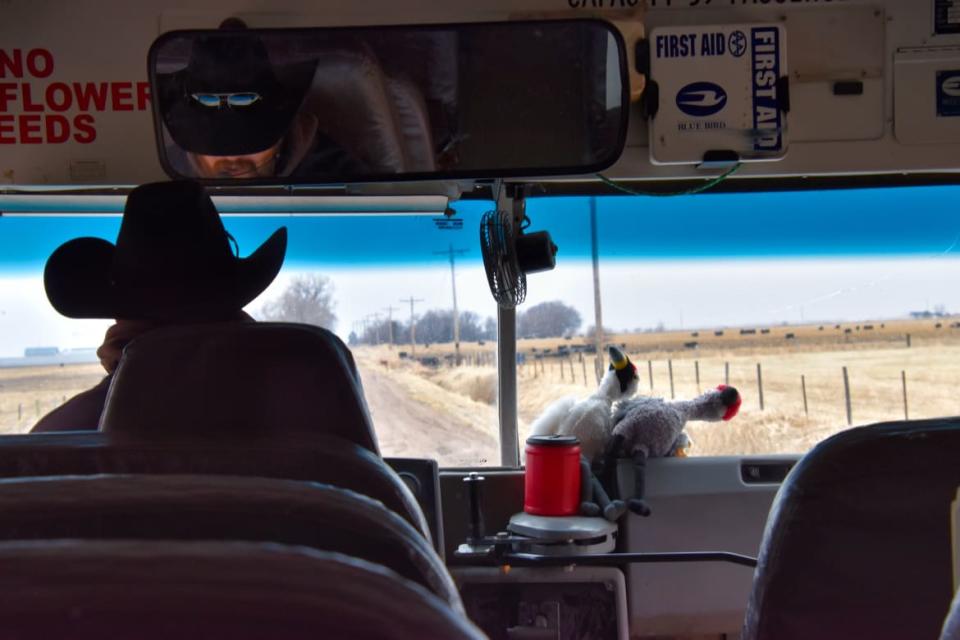
Dusty Trails bus tour in North Platte Nebraska.
That night in North Platte we stepped into a cozy blind with small floor heaters, and watched them return to the river in small batches, collecting over the water, tucking their heads into their wings, and drifting off to sleep. I then left North Platte for Kearney, an hour and a half to the East to also catch some sleep at a Best Western.
The next morning I got up before the sun and made my way to Audubon’s Rowe Sanctuary in Kearney. The Iain Nicolson Audubon Center at Rowe Sanctuary focuses on conservation along the Platte River. Guests can register in December to get one of the limited slots for viewing the cranes in their bird blinds. Most of the openings fill up on the first day of registration. Their blinds have warming rooms for cold mornings and windows that open up for cameras.
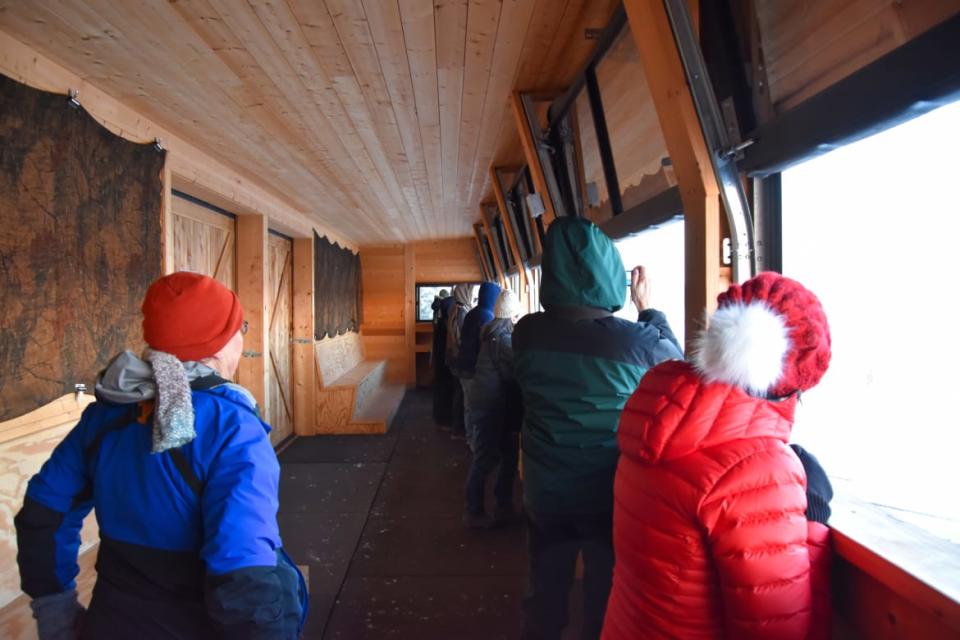
Bird blind at Rowe Sanctuary in Kearney, Nebraska.
We sat quietly in the dark, waiting for the sun to come up. Flashes and camera sounds are not allowed right away. The birds were close enough that they could hear or see them and get spooked.
But this is where it gets magical.
The river is necessary for the cranes. It is shallow and wide enough that they can roost on sandbars together, giving themselves a view from all angles to spot predators.
Sitting in the quiet, we watched the birds come to life. As the sun rises, the cranes shake off their slumber and pull their heads out from under their wings. They begin calling to one another. It’s low at first, but the sun is almost like a volume dial, and as the light creeps in over the river, the birds grow louder, cacophonous, and deafening. From this point, cameras can be used. Suddenly, as if one of them said it was time to go, they all lift-off the river in one mass. Tens of thousands of birds fill the sky, flapping and calling. It stuns the senses.
Then they’re gone for the day.
Well, usually they’re gone. That morning, I had a rare chance to see them do it three times. More than once, a predator had triggered a flight earlier than expected. They lifted off, but returned en masse shortly after.
The Platte River isn’t perfect, though.
“The river, historically, probably would have 200 miles of wide, shallow open channel habitat for the birds,” said Bill Taddicken, director for the Rowe Sanctuary. “Now they have been condensed down into about an 80-mile stretch. And within that 80 miles, there’s only maybe 20 or 30 good miles of river for them. Because what they want is a wide shallow channel that they can roost in all night long.”
He adds that, due to dams, 70 percent of the water is gone before it gets to them. “There’s always somebody wanting more water,” adds Taddicken. “The river itself is over-appropriated from here to upstream.”
This is a theme I heard from the moment I landed in Nebraska. The question is, when will it impact the cranes? When the river dries up, the river bed gets filled with vegetation and the banks begin to enclose the areas the birds rely on for safely roosting.
“The cranes have compromised about all they can,” Taddicken noted. “The numbers are good right now for sandhill cranes, but we don’t know where the tipping point might be. And if the river dries up for any real length of time during a migration season, it can be a real issue.”
The rest of my day was exploring Kearney before heading to the Fairfield Inn in Grand Island for a night’s rest before another early morning.
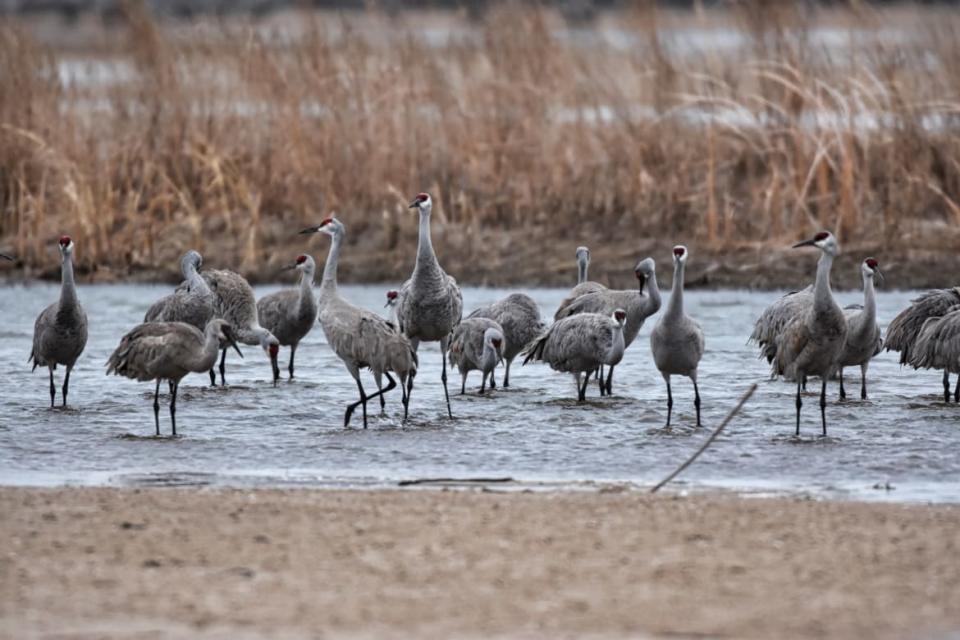
Sandhill cranes at Crane Trust on the Platte River in Grand Island, Nebraska.
Grand Island is home to Crane Trust, which conserves habitat on the Platte River in South Central Nebraska. I got up before the sun and met Brad Mellema, the former director of the Crane Trust Nature Center and now director of Grand Island Tourism. We parked in a field and walked to a small blind, which serves as a photography blind. He set up a tripod and we waited.
The blind is a shack really, with windows made of netting and holes cut into it for cameras. It’s quiet. It’s bitter cold. It’s also only 50 yards from the birds and it gave us a chance to watch them wake up from close.
The Crane Trust is a fascinating organization, focusing on conservation, research, and education. Their land helps the sandhill cranes, but also other species, like that of the endangered whooping crane. There are just over 540 migrating individuals left. In a rare moment in North Platte on my Dusty Trails bus tour, we spotted one in a field.
They also reintroduced bison to Nebraska on their land. Bison traditionally wallowed on the land, forcing vegetation to restore itself, which naturally maintained prairie. This restoration of prairie is helpful for any species, like cranes, which traditionally visited the land when bison were the dominant species.
“Our mission is to protect and maintain land throughout the Platte River Valley,” Brice Krohn, the president and CEO of Crane Trust told me. “So it’s a lowland, tall grass prairie on the largest tracks that’s left of this contiguous grassland.”
“We are worried about the headwaters of the Platte... it’s a sediment-deprived river system, just because of all the dams,” adds Krohn. “Water is key for everything.”
Crane Trust was originally formed out of a lawsuit in 1978 over the construction of the Grayrocks Dam on the Platte in Wyoming. Payment from that lawsuit went into an endowment for the Trust’s creation and funding, though donors make up the lion’s share of their budget now.
This is where tourism and birding work together. Tourism helps to draw public attention to these issues, raise money for it, and incentivizes conservation.
For many birders, migrations, like that of sandhill cranes, are a type of pilgrimage—for a brief, special point in time, they get to connect with these birds.
One pre-pandemic study showed that birding had an economic value of $41 billion. Birding is a big industry that not only occurs in backyards and local parks, but draws people from across the globe. In some areas of the country, birding festivals are significant players in local economies.
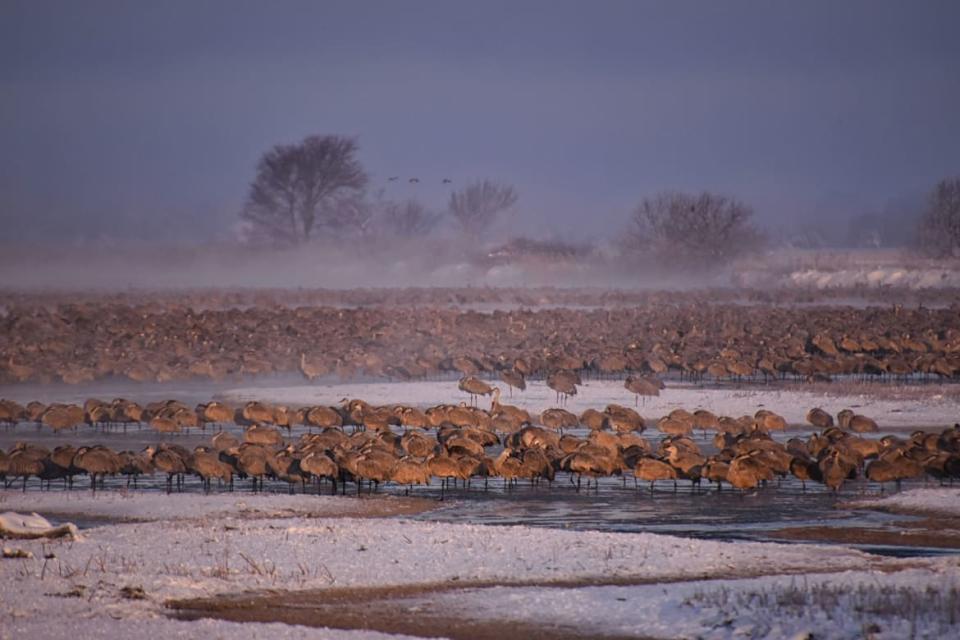
Sandhill Cranes roosting at sunrise at Rowe Sanctuary in Kearney, Nebraska.
Every Spring in Ohio, nearly 100,000 birders will flock to Magee Marsh, Howard Marsh, and other areas of the Toledo Metroparks system around Lake Erie for The Biggest Week in Birding, spending around 40 million in just a few weeks for the warbler migration. In November in Harlington, Texas, The Rio Grande Birding Festival also brings in millions. The sandhill crane migration is also one of those moments in the year where birders go to find those unique experiences and species they have yet to see.
Those tourism dollars benefit everyone.
During my time passing through North Platte, for example, I got great pulled pork at Good Life on the Bricks. In Kearney, I stopped into Alley Rose for lunch and visited the Great Platte River Road Archway Monument, a multi-story roadside attraction, which stretches over I-80 and tells the story of those who have traveled the Great Platte River Road since the Oregon Trail. At Grand Island, I enjoyed beers at Prairie Pride Brewing Co. and tried four different pizzas at the wonderfully quirky, surfer themed, Wave Pizza. I also visited the Wings over the Platte exhibit at the Stuhr Museum in Grand Island, which features different artists and their takes on the sandhill cranes.
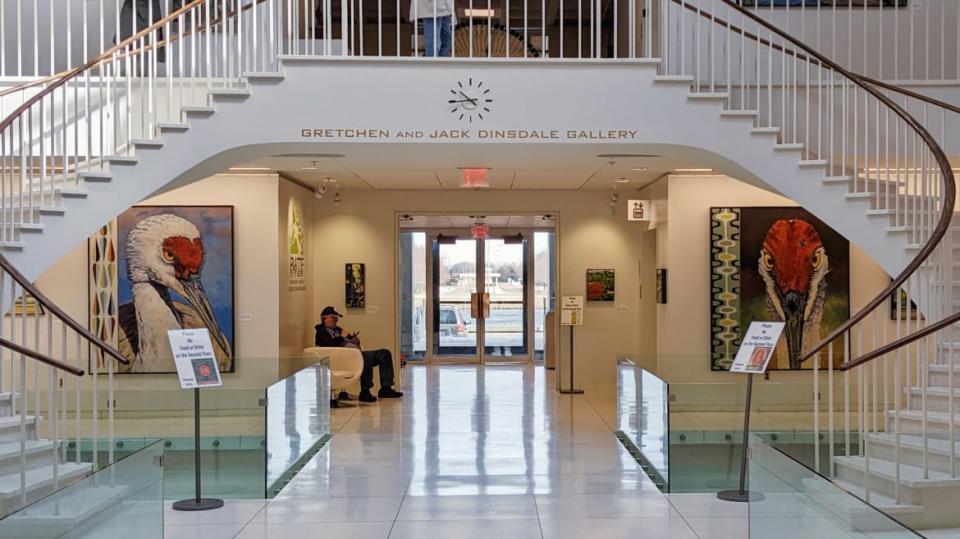
Wings Over the Platte exhibit at the Stuhr Museum in Grand Island, Nebraska.
My final night, I sat in one of the Crane Trust’s blinds intended for guests—fully heated and comfortably out of the cold. We watched the birds return to the Platte River to sleep. This is not just a pilgrimage for birders, it’s also a pilgrimage for the birds.
I can hear them chatting as they get closer, like they are asking, “How was your day?” “Did you get to eat?” “Have you found a mate?” “And what’s up with the white bus in North Platte?”
Cranes coming together in this way feels like a party, and I think I’ll make this pilgrimage again next year.
Get the Daily Beast's biggest scoops and scandals delivered right to your inbox. Sign up now.
Stay informed and gain unlimited access to the Daily Beast's unmatched reporting. Subscribe now.

